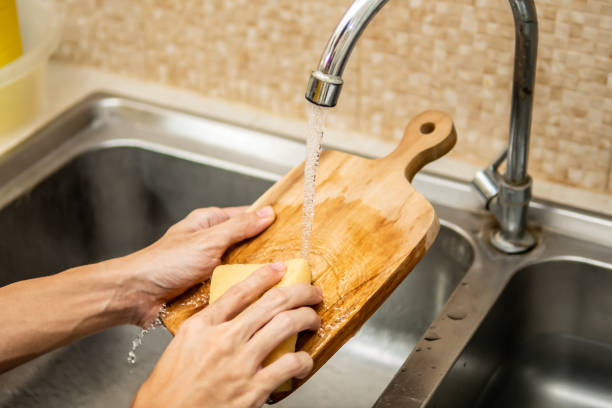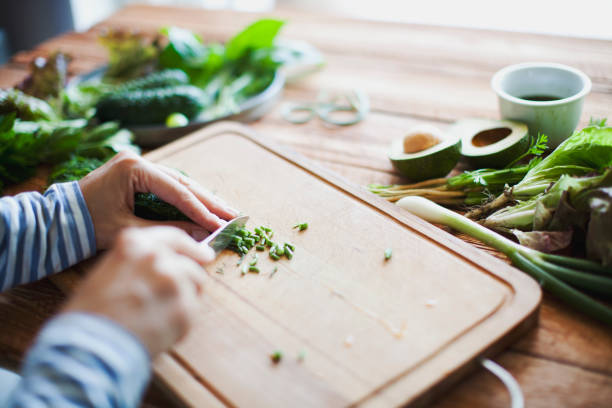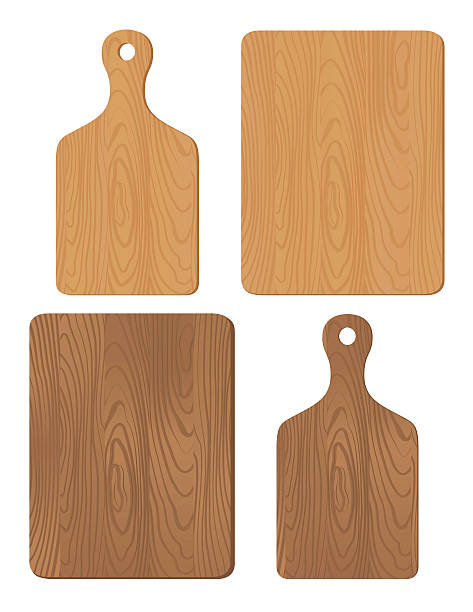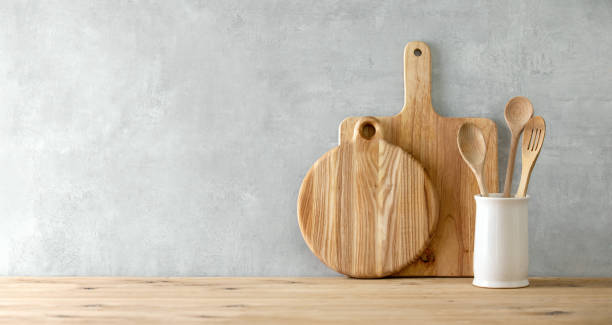It may seem like a hard task to find the ideal chopping board for your kitchen, but once you do, you won’t want to give it up. If you want your wooden board to last as long as possible, proper maintenance is essential. What better approach than to follow these easy steps for oiling a cutting board? How often to oil wooden cutting board?
Don’t be put off by the fact that there seem to be an infinite number of guides on how to grease cutting boards and butcher blocks in different ways and the frequency of doing so. Here, you’ll learn simple strategies for keeping your right hand safe as you cook.
How Often to Oil Wooden Cutting Board – Cleaning Guide

Consider the wear and tear that cutting boards endure on a regular basis. What you use it for determines how often and how you clean it. Keep your wooden cutting board away from water and the dishwasher.
The wood will warp and possibly break because the cleaning machine is too hot and moves around too much. Plus, bacteria love to hide in the crevices of a wooden cutting board. Warping can also occur if a hardwood cutting board is kept in a damp environment, such as the sink.
🔶 Cleaning Cutting Board After Light Use
Use a paintbrush or washcloth to remove dry crumbs from the cutting board if you just use it for bread cutting. A simple wipe is all that’s needed after utilizing a dry cutting board.
🔶 Cleaning Cutting Board After Heavy Use
After each use, a hardwood cutting board should be hand-washed. Scrub the board with a rough sponge and some hot, soapy water. You need a sponge that is going to go into the wood but is not thick enough to rip it apart. That can help ensure getting every part of the board.
If you wish to stop bacteria from multiplying in certain spaces, disinfect them. You should let the cutting board air dry before putting it away to stop the growth of mold and bacteria. Use a dish towel to clean the board, then set it upright to dry completely.
🔶 Removing Stains and Odors
Experts say that you can get rid of lingering smells and tough food stains by using white vinegar. To clean the board, mix one part white vinegar with four parts warm, soapy water and scrub the board thoroughly, paying special attention to the soiled areas. Stronger stains may ultimately fade as you repeatedly wash your cutting board.
A different option is to use coarse salt to scrub the wood and remove the discoloration. If your cutting board has been ruined by mold, this technique will get rid of the stains quickly and easily. Wash the board in warm water when the stain begins to come loose. If required, rinse and repeat, and then pat dry.
Is there a Need for Cutting Board Oils and Creams?

Before discussing how often to oil a wooden cutting board, let us first cover why oils and creams are needed for cleaning wooden cutting boards. Generally, the board is oiled so that the oil soaks into the wood fibers. This keeps blood, germs, and moisture from getting into the board. Also, a well-made cutting board will keep its shape even when the wood fibers are wet, unlike a dry board that has been wet.
Warped cutting boards are typically the result of this contraction and expansion process. In this case, we see a bamboo cutting board that has been greased on one side and left to dry on the other, requiring “no care.” That is to say, cutting boards made of wood or bamboo require periodic oiling.
Board oil protects the wood from the inside out, while board cream or wax creates a protective wall on the wood’s surface to keep out liquids and stains. Wax helps keep things clean because it can be rubbed into cuts and tiny crevices to prevent bacteria from getting in.
Frequency of Oiling the Wooden Cutting Board – When to Oil Your Cutting Board?
What is the frequency of oiling your wooden cutting board? Well, the optimal frequency of board conditioning is not known with certainty. Whenever it is time to do something, just check your board to see. A luminous spot will be in the middle, while the rest will be dry and grayish.
Do it twice per season, or eight times per year, if you really need a miracle recipe. About once a month, I will oil my boards. Because they need to be washed so often, oiled cutting boards need to be taken care of all the time.
Considering climate change is also important in determining how often to oil wooden cutting board. In the cold, when we use the heater frequently and the house becomes dry, I have to oil my chopping boards more frequently. It’s time to replace the board if you see any severe cracks in it. Bacteria can easily take over these places because food and water are easy to get to.
How to Maintain a Wooden Cutting Board and How Often
Wooden cutting boards should be cleaned after each use by scrubbing them with hot, soapy water. Once wooden cutting boards and other kitchen supplies were left in water any longer, they will break and warp. To prevent the spread of bacteria, some people disinfect their cutting boards with a weak solution of diluted bleach or hydrogen peroxide after they’ve been used to prepare raw meat.
Depending on how often you use them, boards and spoons may also benefit from occasional oiling to protect their finish and keep them from getting dry. Some folks I know do this once a year, while others do it once a week. This happens approximately once a month at my place.
When Should You Season a Cutting Board of Wooden Type?
A board should be seasoned at least three times before it is used for the first time. Whenever the finish begins to seem worn, it ought to be seasoned once more. Emmet’s Elixir Wood Conditioner is a food-grade mineral oil mixed with naturally antimicrobial oils. It is highly recommended for restoring and sealing wooden surfaces like cutting boards, butcher blocks, and tabletops.
It’s the only wood conditioner on the National Sanitation Foundation’s approved list, so you can feel good about using it in your eatery. Just spread the elixir on, buff it in, let it sit until it absorbs, and repeat as necessary.
How Often to Oil Wooden Cutting Board – the Best Board Oil to Use

The oil used on wooden utensils and cutting boards should be of food-grade quality and not go rancid easily. Because mineral oil is widely used and inexpensive, it can be found in most supermarkets and home improvement stores. Beeswax and mineral oil are used in the handcrafted wooden spoon butter. In addition, you can find cutting board oils and creams by name brands at most supermarkets and home improvement stores.
Make sure the boards are spotless before you begin. My go-to scrub is a lime slice and salt solution. Plan ahead to ensure the boards are dry before applying oil. The oil needs as much time as possible to penetrate. Before going to bed, I apply the oil, and then in the morning, I just offer them a wipe-down to remove any excess.
☀ Cutting Board Oil Coverage and Shelf Life
- It is estimated that 250 milliliters (8.5 fl. oz.) will cover about 200 square feet.
- About 400 square feet can be covered with 17.0 fl. oz. or 500 ml.
- When the seal is broken, you only have three more years to use the contents.
Step-by-Step Instructions on Oiling a Cutting Board
The time and effort required to oil and season a cutting board is a myth. A straightforward, methodical approach is what we’re going for. A clean, dry cutting board is the best place to begin.
Step 1: Oil the Cutting Board and Set it Aside
Get your area’s feature oil—whether it’s mineral oil, beeswax, etc.—ready to go. Spread it out on the board, beginning on one side. Willingly give. You shouldn’t be too stingy with the oil, but you also don’t want it to pool on the chopping board. Slowly drizzle in the oil, checking after each addition to see if more is needed.
Step 2: Rub It In
Mineral oils can be rubbed into the blade with a clean, soft dish towel or paper towel. Working in a circular motion allows the oil to penetrate the wood evenly. Don’t skimp on detail. Oil the entire board, down to the last nook and cranny. The handles and any bumps near them should be smooth as well.
Step 3: Repeat the Process
Set the board upright and wait a couple of minutes. If you haven’t oiled your cutting board in a while, it’s probably quite dry and could use a few extra coats. In that scenario, if necessary, you can do Steps 1 and 2 again.
Step 4: Wipe Away Excess Oil
After massaging the grease into the chopping board for about ten minutes, you can remove any remaining traces of oil with a paper towel. The pooled liquid could develop cracks in your board, but if you do this, you won’t have to worry about that happening.
Step 5: Let the Board Rest Overnight
At that point, you can leave your cutting board propped up on a dish rack, for example, for the night to dry. You may wait as little as three hours if you’re in a hurry, but the longer you wait, the more thoroughly the hardwoods will absorb the oil. Keep in mind that you should wait to put away your chopping board or counter until it is entirely dry.
Preparing a Wooden Chopping Board for Use

When your board dries out and fades in color, this is a sign that it needs to be treated. One month between oilings is recommended. You need to condition your worktop once a week if it is expensive or if you use it as a piece of decor in your kitchen. On cutting boards, the recommended oil to use is a mineral oil that is food-grade.
✔ Start by thoroughly cleaning and drying your cutting board.
Due to the fact that water and oil are natural enemies, if there is any moisture left on the cutting board, the oiling procedure will fail.
✔ Apply mineral oil on the chopping board by rubbing a paper towel across it.
Try to be liberal with olive oil. Oil should be applied so that it almost drips off the wood. When applied to wood, oil prevents cracking and drying.
✔ Don’t touch the panel for at least four hours while the oil is soaking in.
Letting the board stand on its shorter end can help keep it from warping because the extra oil can drain away. Doing the oiling process twice or three times if this is the first time you’ve washed a brand-new board. By doing this, the board will be well-seasoned and ready to be used again.
Sanitizing a Wooden Cutting Board
Hydrogen peroxide is a good disinfectant, and if you are working with raw meat and need to clean your board, you should use it. Pour hydrogen peroxide on the board from all sides and then use a clean sponge to spread it out evenly. After letting it sit for a while, wash the board with lukewarm water.
Additional Advice on Maintaining Your Cutting Board

- Use a damp sponge or dish towel to wipe off the cutting board as needed throughout the preparation process. This will facilitate the final cleaning process.
- When you’re done using the cutting board, wash it well. This prevents stains, spills, and odors from seeping into the wood. Have you ever cut into a fresh apple, only to find the flavor spoiled by the garlic you cooked into soup the day before? This won’t happen if you wipe the board down after each use.
- As soon as you’re done preparing raw meat, wash the cutting board with disinfectant. You can use either distilled white vinegar or even a mixture of 1 1/2 teaspoon of chlorine in 4 of water.
- To remove lingering odors from a cutting board, such as those left behind by onions, just rub a cut lemon over the surface, let it rest for a moment or two, and then wipe it clean.
Frequently Asked Questions
Q: When should I last oil my wooden cutting boards?
The amount of use, frequency of cleaning, and weather conditions will determine how often you need to oil your board. Because most people don’t oil their boards nearly often enough, you should plan on doing yours more often than you might imagine. Put oil on both sides of the board to keep it from warping when the humidity changes. If you want to keep your cutting board clean and easy to clean afterward, we advise lightly oiling it before using it to prepare meats.
As you use your board with things like garlic and fish, you don’t want the wood to absorb those smells and oils, so oiling it is a good idea. To avoid rancidity, avoid using olive and vegetable oils.
Q: What types of wood are generally preferred?
Maple, Walnut, Cherry, and Sapele are the woods of choice for our cutting boards. Maple is the wood with the tightest grain and the highest hardness. Butchers prefer end-grain maple blocks because they are strong and easy on knives. Softer woods like walnut and cherry still make great cutting boards and add a splash of color to the kitchen.
Sapele is a common African hardwood that resembles mahogany and has a straight grain. Quarter-sawing brings out the wood’s glittering grain, and its density, sustainability, and versatility make it ideal for cutting boards.
Q: How long should I wait between washing and oiling a cutting board?
Protect your hardwood cutting board from dampness and damage like cracking and splintering by applying cutting board oil regularly. The oil on your cutting board could go rancid if you don’t get the right kind. Before oiling, make sure the board is completely dry; then, oil it when you can and let it soak overnight, such as before each use.
Q: When using a brand-new cutting board, is it necessary to oil it?
A brand-new cutting board does require oiling. Without regular oiling, the wood will dry out and split. Wooden cutting boards should be seasoned and cleaned as soon as possible after purchase. Mineral oil, or another oil that is acceptable for use with food, can be used to season a fresh board. Simply apply a little coating and rub it into the wood with a paper or cloth towel. Any extra oil should be drained.
Final Thoughts
Once you learn how to properly clean and care for your wooden cutting board, it will serve you well for many years as a durable and reliable chopping surface. This kitchen workhorse can last for years with just an annual scrubbing in warm water and soap, spot treatment with white vinegar, oiling, and light sanding. We are hoping that the discussion about how often to oil wooden cutting board will help you to maintain it in the long run.
